This story was produced by The Hechinger Report, a nonprofit, independent news organization focused on inequality and innovation in education.
On a Friday evening in the fall of 2019, Maria Flores stood waiting with her “crazy heavy” duffel bag and her teenage son outside the office of a man whose home she cleans. A friend of hers had told him that Flores had been evicted from the apartment she had lived in for 16 years. There, the single mom had paid $700 a month in rent ever since she’d moved in eight-months pregnant. Now, one night at a motel cost as much as $250.
“Every single day I was looking for a place to live,” Flores said.
He’d offered two air mattresses, keys to his office and permission to sleep there on weekends. For the better part of a year, Flores, who asked to use only one of her two surnames, lived that way: Back and forth, spend and scrimp. But there was no shower or kitchen at the office. And on this Friday, someone was working late. Flores’ son, who asked to be referred to by his middle name, Mateo, begged to go to a motel, but Flores told him if they did, they’d have no money for food.
Still, she didn’t want to go to a shelter.
“Everything that I heard, it was something about drugs, it was something about people being in a quarrel,” Flores said.
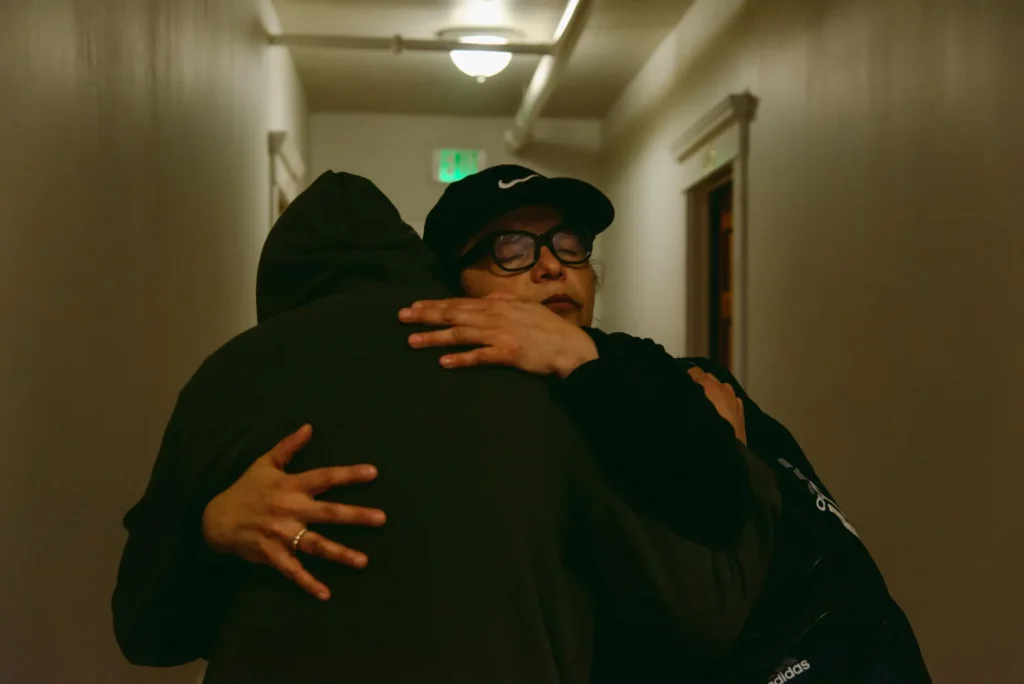
There was one other option. A few months earlier, she’d heard about a family shelter inside an elementary school gym. Every evening, after the students and teachers left, partitions were snugged to the back wall, creating three-sided squares for kids and caregivers to set up sleeping pads on the floor. Cafeteria-style tables in a connected room hosted dinner and, later, homework. Only families with a child enrolled in the San Francisco Unified School District could be admitted, and Mateo was a high school junior.
“I didn’t want to,” Flores said of calling the school-based shelter that Friday night, “but I was so tired.” Standing on the sidewalk in a neighborhood known for open-air drug dealing, with the sky growing darker, and then darker still, she decided she and Mateo didn’t have a better option. She took out her phone and dialed the number.
The idea of optimizing school district property for evening and weekend use isn’t new, but Buena Vista Horace Mann K-8 Community School (BVHM, for short) appears to be the first modern public elementary school to have hosted a long-term, overnight family shelter.
“As far as our knowledge in the entire country, we are the first people to do it,” said San Francisco City Supervisor Hillary Ronen, who was instrumental in advocating for the program.
Some objected: Shelter should not be the responsibility of a school, they argued.
And yet, “We were the folks that were willing to do it,” said Nick Chandler, the BVHM community school coordinator.
His school serves approximately 600 students in the heart of San Francisco’s Mission District, three blocks from the exclusive Adda Clevenger School and across the street from a restaurant serving a $16 roasted octopus appetizer. Just under 60 percent of the students are English language learners, and just over 60 percent have been deemed socioeconomically disadvantaged, though that’s an undercount according to the school’s staff who say many of their families are also undocumented or under-documented.
One night in 2017, a desperate parent talking to Chandler in the school’s front lobby asked: “Can we stay here?”
The answer that night was no, but the question hung in the air. The school’s wellness team had noticed more and more families in crisis. They’d try to make referrals to the city and nonprofits, but often nothing would come of it. Sometimes the waitlists were too long and sometimes it wasn’t clear what list a family should even be on.
“The process is so intense and it requires so much documentation and follow-through and systemic understanding,” said Claudia DeLarios Morán, BVHM’s principal. “So it was a frustrated group of social workers and counselors and teachers saying, ‘What happened to this child?’”
Kids without a regular place to sleep at night weren’t showing up ready to learn, Chandler added. “And how could they? Your brain is not relaxed. You’re not in learning mode, you’re in survival mode, you’re in flight or fight mode.”
BVHM’s staff had been trained in trauma-informed care, but they wanted to help kids not just to overcome, but to avoid altogether the experience of sleeping in a car, living in an overcrowded apartment, or having a parent stay in an abusive relationship to keep a roof over their heads. The staff knew the office common area couldn’t work, but the gym was a different story. Like most school gymnasiums, it has domed fluorescent lights affixed to the rafters, blue gymnastics mats cushioning the walls, and basketball hoops. The adjacent room, with those six tables and a microwave, sports a teacher-lounge vibe.
When not a single teacher objected, the BVHM team brought the idea of hosting a shelter for the school’s families to Ronen, the city supervisor, and the group then pulled in Shamann Walton, a member of the San Francisco Board of Education at the time. They were careful not to suggest having a shelter would solve everything.
“This is a band aid,” Ronen said. “This is not a root-cause fix of the problem of childhood homelessness in this country.”
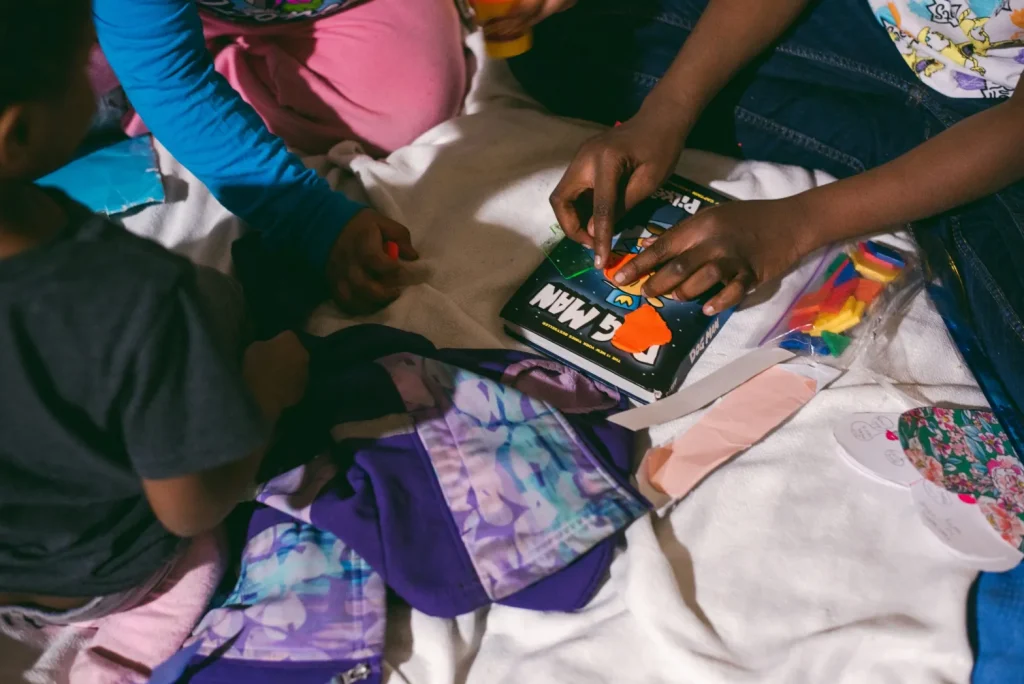
Over the course of April and May 2018, Ronen, Walton and others fielded questions at public meetings. “We didn’t ask Claudia [DeLarios Morán] and Nick [Chandler] to take this on on their own,” Ronen said, “We stood up, and we took the heat with them.”
And there was heat. A vocal minority worried that a shelter would draw an unsavory crowd to the neighborhood, that the gym would be left smelling like urine, the playground littered with needles and cigarette butts.
School administrators took questions, submitted during the meetings and afterward, and created an FAQ document they posted online.
“How will the administration guarantee … that no drugs, alcohol, or weapons will come on to the premises?” is one. “Will people with a criminal record … [or] mental illness be allowed to sleep in our school?”
The answers reflect patience with these two questions and others laden with assumptions about who experiences homelessness and how: “The participants will be BVHM students and their immediate families. These are the same people at back to school night, performances, daily drop off and pick-up,” the BVHM team replied.
Much of the pushback centered around, “Why us?” Some commenters worried school administrators would be in over their heads running a shelter and others suggested alternatives, like transitional housing or co-living spaces. “Our program is a response to a lack of space in these,” the administrators answered, adding that a third party would manage the BVHM initiative.
Another proposal: Ask other BVHM families to open their homes instead. The school welcomed offers. They received none, Chandler said.
“The PTA meetings were hell, with this undercurrent of disliking poor people,” said Sam Murphy, a white BVHM parent, who witnessed this back-and-forth.
The school’s Spanish immersion program attracts some privileged families in a competitive lottery system, and one woman told Murphy the shelter, by then dubbed the “Stay Over Program,” would “lower the cachet of the school.”
Despite the loud objections from some, the school had, in Chandler’s words, a “real strong voice from our folks that had been there or had been in similar situations.” With the bulk of the community on board and the support of the mayor, the project moved forward.
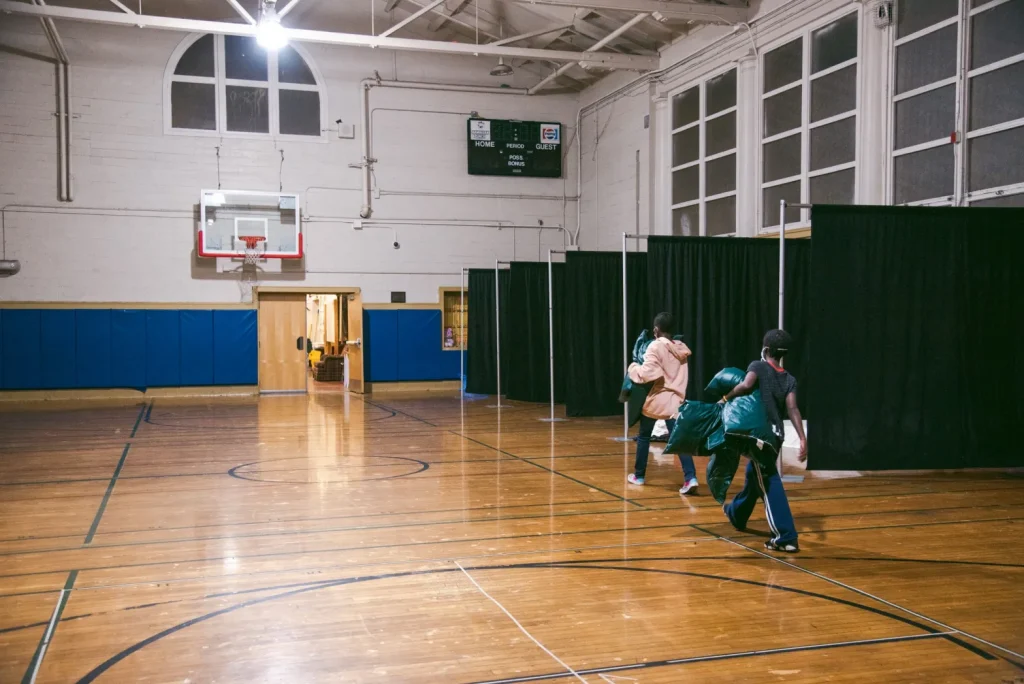
It started as a pilot program, funded entirely by the city, with a joint use agreement allowing a Department of Homelessness and Supportive Housing program to be operated on school district property by Dolores Street Community Services, a community-based organization with experience running shelters. This kind of interagency and public-private cooperation may seem intuitive, but it can be quite a logistical feat. In this case, that included getting the approval of the fire department, planning commission, and city attorney, as well as integrating the program into the city’s preexisting web of access points and services — and, on top of that, building political alliances.
“There are a hundred ways to shut this kind of idea down,” Ronen said. But the idea persisted and turned into a plan and then a place.
The shelter soft launched in November 2018; in January 2019, after an architect from the neighborhood offered to figure out how to install showers beside the gym and a construction company did the work pro bono, the Stay Over Program at BVHM, first of its kind, officially debuted.
Before then, Chandler said, he and other school staff “knew the families, we didn’t know the services; the city knew the services, they did not know the families.” Now, that has changed.
The idea that schools can act as resource hubs for students and their families is known broadly as “community schooling” and has proven successful across the country.
“A vast body of research shows that schools and communities can mitigate the effects of poverty by providing support to children and families to address basic needs such as housing instability,” said Pedro Noguera, dean of the University of Southern California’s Rossier School of Education.
Students experiencing homelessness are more likely to display symptoms of post-traumatic stress disorder, anxiety, and depression — even behaviors that look like ADHD. “[T]he experience of homelessness is associated with difficulty with classroom task engagement and social engagement,” according to a report by the Learning Policy Institute. (Core operating support for the Learning Policy Institute is provided by the William and Flora Hewlett Foundation, one of the many funders of The Hechinger Report, which produced this story.)
These students are also more likely to be referred for discipline, including suspension. They are more likely to attend schools with concentrated poverty, and they score significantly lower on state testing than other economically disadvantaged students. Students grappling with homelessness are also less likely to graduate high school and less likely to attend college. They are more likely to change schools and be chronically absent.
“For English language learners experiencing homelessness,” the report concludes, “fewer than 9 percent met or achieved state standards in mathematics.”
Nationally, 37 percent of students experiencing homelessness are chronically absent, according to Barbara Duffield, executive director of SchoolHouse Connection, a Washington, D.C.-based nonprofit. That percentage is likely much higher now, she said, in light of pandemic-related barriers.
A 2020 report from UCLA’s Center for the Transformation of Schools, funded in part by the Chan Zuckerberg Initiative, found that several indicators of educational distress — including suspensions and absenteeism rates — are, on average, worse for Black, American Indian, Pacific Islander, and multiracial students experiencing homelessness. (The Chan-Zuckerberg Initiative is one of the many funders of the Hechinger Report.) Thanks to a racial knowledge gap in the data, it’s unclear whether that pattern extends to Latino students, said UCLA’s Edwin Rivera, co-author of the 2020 report.
Not enough BVHM families have used the Stay Over Program to make a dent in the school’s overall statistics, but, said DeLarios Morán, “For families that stayed there, absolutely it stabilized their attendance.”
Maribel Chávez, a first-grade teacher at BVHM, said that before one of her students started sleeping in the gym, he usually arrived late and with an empty stomach.
“Not having a specific place that they are coming from every day, there wasn’t a routine,” she said. He would miss the opening song and the preview of the day’s schedule. She’d try to give him a quick recap and “scrounge up some snack,” but it wasn’t enough. He threw objects, tried to leave the classroom, and hit other students.
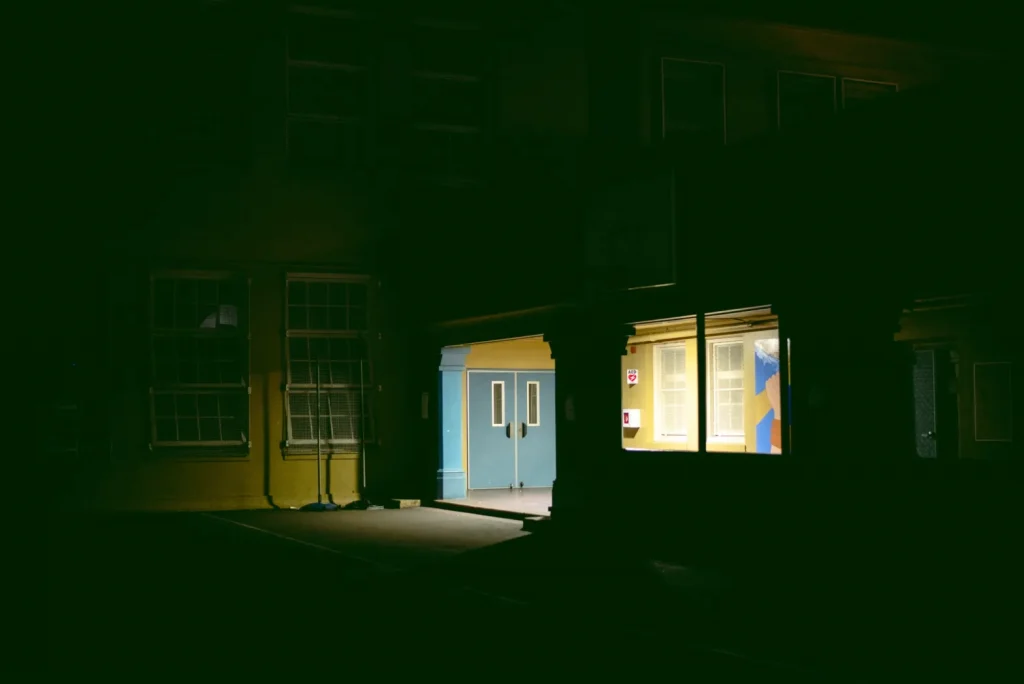
For a while, his was one of several families living in a single apartment. He shared a room with his mom, Olga, who prefers to use only her first name, and his two brothers. Then other residents of the unit started to complain about his oldest brother cooking after his late shift. Little conflicts became bigger ones until Olga found herself trying to hold off using the bathroom so she wouldn’t run into anyone in the hallway. After calling the police to say she suspected one woman had intentionally left the stove on, filling the apartment with gas, she left. They stayed with a variety of family members and friends for more than a month before Olga and her two youngest sons landed in the BVHM gym.
With lights out at 9 p.m., breakfast every morning, and a transition straight to the school’s before-care program, Chávez said, she found the first grader “in my line and ready to go” at the start of each school day.”
She noticed a shift in his demeanor (“happier”) and behavior (“so much calmer”). He and the other students who have utilized the Stay Over Program “were able to come in and be present, to do their work and learn,” she said.
Soon, the benefit of small group instruction and literacy interventions kicked in. “The other day we were reading together,” Chávez said, “and I was like, ‘Wait! Wait. Wait. Did you just read that?’”
Stories like this one make DeLarios Morán feel that it is indeed her school’s responsibility to help students find safe and reliable housing.
“If the child is not stable, that’s a barrier to their education,” she said. “So that’s why we felt like as an educational institution, we had a mandate.”
But while public schools are required to offer a handful of services to students who are experiencing homelessness, the federal legislation that channels money to districts to support those services can’t be spent on housing. The available funding, known as McKinney-Vento after two U.S. Congressmen who championed the legislation, has long been grossly inadequate. That said, other federal funding streams are available to support a district-city partnership like this one, including money from FEMA and the Department of Housing and Urban Development. State dollars are often at hand. And in San Francisco, a business tax passed in 2018, a 2020 health and recovery bond and private donations together provide hundreds of millions more.
Ronen, the city supervisor, acknowledged that San Francisco’s comparatively large budget for addressing homelessness has facilitated the program, and being a sanctuary city helps too. She thinks any similar program would need a principal and staff who aren’t scared of innovation, maintain a problem-solving mindset, and see basic needs as part of their mission. But none of that is specific to BVHM.
“It’s a community school mentality, and BVHM is not the only community school in the country,” she said.
She did offer a caveat to others wishing to replicate the program: “It should only happen if that is what your community is asking for,” she said. “If this was top down, if I have this idea and impose it upon the school and the school district, it would not have worked. But is San Francisco a unicorn? I don’t think so.”
DeLarios Morán was more bullish: “They just have to follow the blueprint,” she said. “We’ve done it now. So, it’s not like they have to create the wheel.”
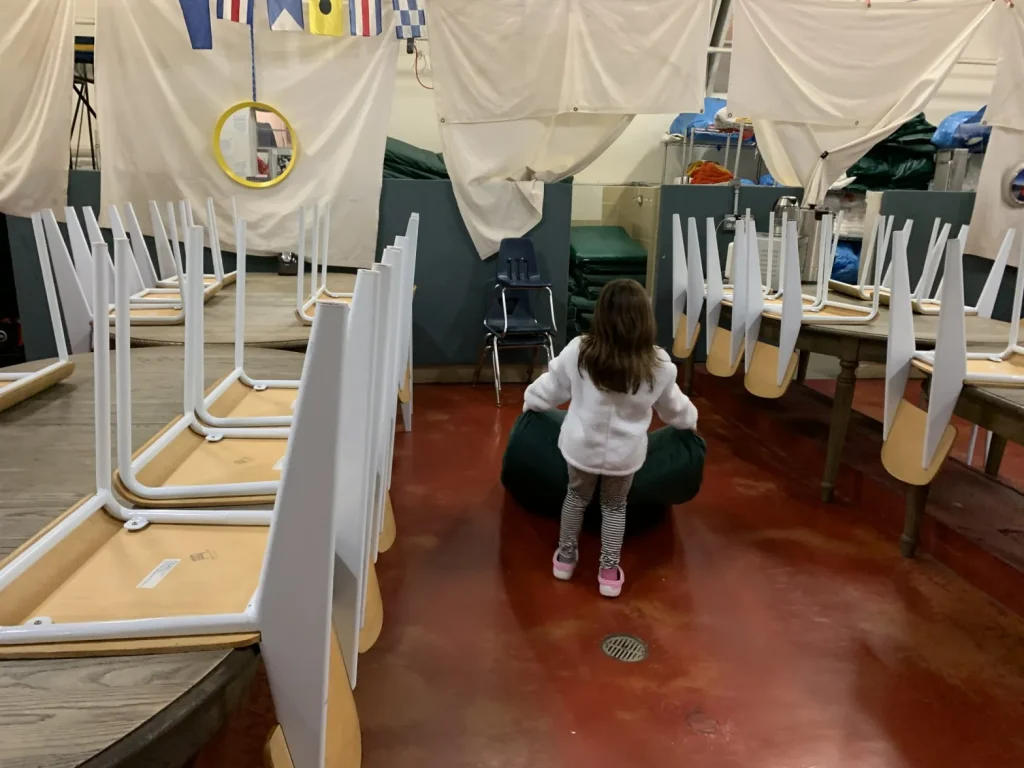
When the shelter first launched, it was only for BVHM families, but the per-person cost to the city was too high to make fiscal sense. In March 2019, the school board voted unanimously to expand the program to include students and families from any district school. Monthly occupancy jumped approximately eight-fold: As of January 2020, more than 30 schools had referred students, rendering the program cost-effective, according to a January 2020 evaluation by the San Francisco Controller’s Office.
Dafne is a junior in high school. Her family left the city after her mother lost a catering job during the pandemic and couldn’t pay rent. They drove to Orange County to stay with her mom’s aunt, just until things got better. But a year passed, and then a few more months. When catered events resumed, her mom got her job back and an invitation to stay at a friend’s place in San Francisco until a few paychecks added up to enough for a rent deposit. But four more people turned out to be too many for the friend’s husband, leaving Dafne, her mom, and two sisters sleeping in their car.
Dafne said an elementary school gym isn’t an ideal place to sleep either. At BVHM, she was regularly woken up by a shelter monitor walking by at night and the persistent banging of the old building’s heating system, a sound like a baseball bat colliding with an iron pipe. It punctuated conversation at 2- to 20-second intervals one rainy night this winter. But space heaters, or even white noise machines, aren’t an option because of old electrical wiring.
Moving away meant Dafne lost her spot at the selective high school she’d gotten into, but as a student at a different city high school now, her plans remain ambitious. She wants to go to college and ultimately “focus on real estate and flipping houses.” One of her sisters hopes to be a lawyer. The other, a teacher. At BVHM, the three girls spread out across the tables to do homework, much better than using flashlights in a crowded car, Dafne said.
And the gym felt much safer than the car had, with people peering in the windows at all hours. “We would try to cover it, but it was still scary,” Dafne said.
One of the program’s core components is to do more than shelter families like Dafne’s; walking through the door brings with it entry into a case management system that guides them through the complicated process of finding affordable housing.
Back when she’d been evicted, Flores had connected with a few housing programs, but “[t]hey just were talking about shelters,” she said. When she and Mateo first arrived at BVHM in fall 2019, she brushed off case management attempts because she didn’t want to hear more of the same.
Still, she appreciated having a reliable place to stay. “I cannot complain, being in a shelter,” she said, “At least you don’t feel so lonely.” Headaches she experienced while looking for housing every day started to subside. She was sleeping again. “We were making jokes,” she said, “We had that community.”
Many participants credit that atmosphere to Jacqui Portillo, the program director from Dolores Street Community Services.
“The way she talks,” Flores said, “that’s what convinced me that I can trust her. Jacqui is like an angel for me.”
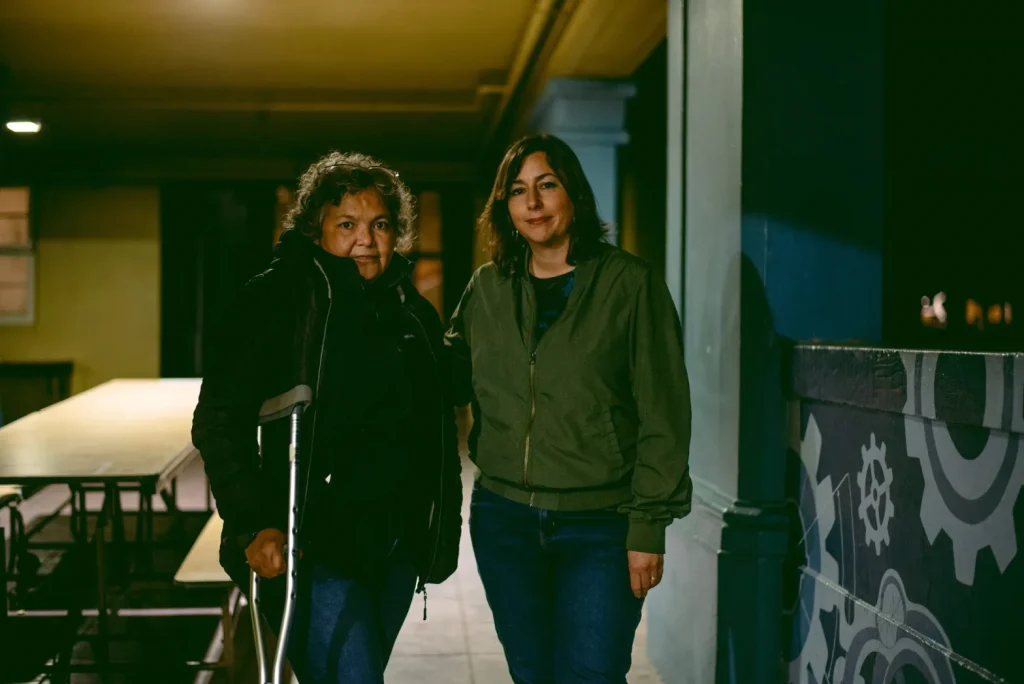
Portillo grew up in El Salvador and went to six years of medical school there, stopping shy of a degree. Instead, she became a nurse and helped run her husband’s business. Their children lived a middle-class existence with swimming lessons and their own rooms until the couple separated. That’s when Portillo headed to the U.S. with her daughters, the oldest of whom was 8. They stayed, for years, in one half of a garage.
“When I came to this country, my life changed,” she said, “I didn’t have language. I didn’t have money.”
She bought her children their first computer with singles, tips from a waitressing gig. Now in their twenties, the oldest went to Wellesley, the middle to Vassar, and “my baby,” she said, to U.C. Berkeley. Portillo wants the kids in the Stay Over Program to have the same level of success.
Once she has a family in the gym, Portillo calls her contacts and asks them to reach out. “If the family doesn’t answer calls from those contacts, she said, “I ask them, ‘What’s happened? Jorge is calling you!’” She keeps gently pestering until the connection is made: “We work with the social worker from the school. We work with the immigration office. We work with everybody,” she said.
For newcomer families especially, Portillo offers empathy, not sympathy. And empathy is what fuels her determination to make the program’s small budget stretch as far as possible. But Portillo refuses to take credit for any accomplishments, including sacrificing her own “off” hours to keep the gym open full-time over the 2021 holiday break rather than making everyone leave by 7 each morning. “God was always with me,” she said.
Crushed by negative news?
Sign up for the Reasons to be Cheerful newsletter.Before the pandemic, experts believed a large number of students experiencing homelessness were not identified; now, the situation is likely much worse. These kids had even greater difficulties accessing online instruction than their low-income, housed peers.
And yet, at BVHM, the Stay Over Program operated 24/7 during the district’s protracted school closure. Children attended classes via Zoom in the room with those cafeteria-style tables and the help of shelter monitors and a case manager, who made sure adults stayed quiet in the gym next door. During breaks they had access to the school’s playground and garden. Over the course of 2020, the program served 146 students. When a family tested positive for Covid, they quarantined in the school’s auditorium.
“Everything was so nice,” Flores said of her time staying in the gym. She still texts with three of the women she met there. “We go and eat breakfast and stuff. So, I have good memories. Really, I do.”
At first, Flores was a newbie, and then she was one of “the old ones.” But others kept leaving, their housing success stories swirling in their wake, and Flores realized she was the last. Eventually, she decided to let Portillo help with her case management. Soon thereafter, she was placed in a residential shelter with a private room for her and Mateo. It wasn’t what she’d envisioned. “When I saw the room, it was like what’s in the military,” she said. “A small room, and it has — what do you call it? — bunk beds.”
Disappointed, she sat down and cried. So did Mateo. “I felt like I was so abandoned,” Flores said.
She had kept all her meetings, done everything right, and still had so much further to go to reclaim the type of home she’d had before being evicted. Situations like this were one of the only negative findings in the Controller’s evaluation. Participants called getting more permanent housing a “waiting game” and said “people get bounced from place to place.”
One of the best things about the Stay Over Program, educators here said, is that rather than adding a burden on educators, it has relieved one. Having a clear protocol for connecting families with case managers who specialize in housing has allowed teachers to teach and allows Chandler, the community school coordinator, to focus on mental health interventions and other areas of need.
“It let us stick to our expertise,” he said. He also noticed a higher level of trust, both from families who’d utilized the program and others who now believe he might actually have the power to help with their problems.
Part of that has to do with the Stay Over Program’s unique features. There is no limit on the number of nights families can stay, families can reserve spots rather than needing to line up for first-come-first-served entry each night, and absence for a night or two doesn’t result in removal. That was important to Flores when she first arrived. She and Mateo wanted to keep sleeping at the office a few nights a week “to be like it used to be, just the both of us,” she said.
These policies are probably also responsible for the program’s unusual continuity. The evaluation found that families stayed a median of 20 days, more than six times longer than at San Francisco’s most comparable shelter, located in a Baptist church. (It closed during the pandemic and has yet to reopen.) But it could be the site. Of the families surveyed for the controller’s report, 79 percent said it was “very important” to be able to stay somewhere familiar, like their child’s school or another school in the district.
When first asked, more than 90 percent of the survey respondents reported that Stay Over Program staff, 90 percent of whom are bilingual, treated them “excellent” or “good.” After they’d stayed two weeks or more, still close to 80 percent said the same. Nearly all said their child really liked (or felt very comfortable) staying in the gym, a number that surprised Ronen given initial concerns about students facing stigma. Duffield, the expert on national homelessness policy, found these results “remarkable.”
The positive reviews don’t mean everything is perfect. Flores said she and Mateo couldn’t take advantage of the free dinner provided, because 7 p.m. was too late for him to eat, but the Stay Over Program can’t open any earlier because BVHM’s after-school program uses the space. Families only have access to small lockers and otherwise have to carry their belongings in and out each day. Having to shower before 6:00 a.m. on the weekend was so early for Glen McCoy and the grandchild he and his wife are raising, that they would drive to a Safeway parking lot and fall back to sleep in the car. Some nights, the banging of the pipes just doesn’t let up.
And yet, Olga — the mom of the now-reading 6-year-old — described the space as “tranquilo,” calm. She stopped having panic attacks and got treatment for a urinary tract infection she’d developed trying to avoid using the bathroom in her shared apartment.
The stability and community offered by the program is temporary, and the path to stable housing provided by this district-city partnership is as long and frustrating for each individual family as the pursuit of eliminating homelessness has been for San Francisco and the nation. But it’s something. And for individual children it has been everything.
“We will not fix homelessness until the federal government believes that housing is a human right,” Ronen said. “Hopefully we will not need [a program like] this in the future, but right now we do.”
Flores and Mateo hadn’t actually been abandoned. They continued to get help from a caseworker, and they finally moved into a subsidized studio apartment in November 2021.
There’s a bathroom they can access any day, at any time. Their showers don’t have a time limit. Flores thinks it sounds silly, but of everything in that crazy-heavy duffel bag she carried around for more than two years, it was the toothbrush that weighed most heavily on her. “It’s something that is private, something that nobody wants to see you use,” she said. And now it stays at home.
They got boxes out of storage. “I have my furniture,” Flores said, “my vacuum!” All the clothes she had looked forward to wearing again no longer fit, a consequence of eating out for more than two years. But now that they have a kitchen, she’s cooking again: “We’re trying to eat some healthy things,” she said.
Mateo doesn’t have to deal with the bunk beds that creaked so loudly he worried about waking his mom, he’s not awoken by shelter monitors at night, and a bed in the apartment beats an air mattress in an office. He’s getting the sleep he needs to focus on his classes at the City College of San Francisco: math, English, and criminal investigation.
But he still doesn’t have his own room, and Flores said they won’t stay here permanently.
“It’s another stop,” she said. “We are getting closer.”





